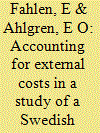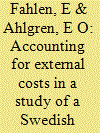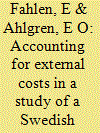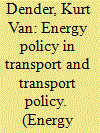|
|
|
Sort Order |
|
|
|
Items / Page
|
|
|
|
|
|
|
| Srl | Item |
| 1 |
ID:
098560


|
|
|
|
|
| Publication |
2010.
|
| Summary/Abstract |
Sweden has historically had strict emission control by implementation of economic policy instruments with the aim of internalising the external costs of air pollution. This study aims to evaluate how well current Swedish policy instruments reflect the environmental costs associated with heat generation in several district-heating (DH) plants in the DH system of Göteborg. Furthermore, it aims to simulate and evaluate the operation of the DH system based on its social cost-effectiveness which takes into account the DH system's private and external costs (non-internalised environmental costs). The study shows that the economic policy instruments do not fully internalise all external costs whereas for certain technologies, the costs in terms of taxes, emission permits, environmental fees, etc. are higher than the environmental costs caused by the pollutants, given the environmental cost estimates used in the study. The simulation results show that the deviating internalisation of external costs affects the economic ranking of the different plants within the studied DH system. The estimated loss in social-cost effectiveness of the operation of the DH system of Göteborg is noticable but relatively small if compared to the variable heat generation costs for most of the studied DH plants.
|
|
|
|
|
|
|
|
|
|
|
|
|
|
|
|
| 2 |
ID:
098576


|
|
|
|
|
| Publication |
2010.
|
| Summary/Abstract |
Sweden has historically had strict emission control by implementation of economic policy instruments with the aim of internalising the external costs of air pollution. This study aims to evaluate how well current Swedish policy instruments reflect the environmental costs associated with heat generation in several district-heating (DH) plants in the DH system of Göteborg. Furthermore, it aims to simulate and evaluate the operation of the DH system based on its social cost-effectiveness which takes into account the DH system's private and external costs (non-internalised environmental costs). The study shows that the economic policy instruments do not fully internalise all external costs whereas for certain technologies, the costs in terms of taxes, emission permits, environmental fees, etc. are higher than the environmental costs caused by the pollutants, given the environmental cost estimates used in the study. The simulation results show that the deviating internalisation of external costs affects the economic ranking of the different plants within the studied DH system. The estimated loss in social-cost effectiveness of the operation of the DH system of Göteborg is noticable but relatively small if compared to the variable heat generation costs for most of the studied DH plants.
|
|
|
|
|
|
|
|
|
|
|
|
|
|
|
|
| 3 |
ID:
098264


|
|
|
|
|
| Publication |
2010.
|
| Summary/Abstract |
Sweden has historically had strict emission control by implementation of economic policy instruments with the aim of internalising the external costs of air pollution. This study aims to evaluate how well current Swedish policy instruments reflect the environmental costs associated with heat generation in several district-heating (DH) plants in the DH system of Göteborg. Furthermore, it aims to simulate and evaluate the operation of the DH system based on its social cost-effectiveness which takes into account the DH system's private and external costs (non-internalised environmental costs). The study shows that the economic policy instruments do not fully internalise all external costs whereas for certain technologies, the costs in terms of taxes, emission permits, environmental fees, etc. are higher than the environmental costs caused by the pollutants, given the environmental cost estimates used in the study. The simulation results show that the deviating internalisation of external costs affects the economic ranking of the different plants within the studied DH system. The estimated loss in social-cost effectiveness of the operation of the DH system of Göteborg is noticable but relatively small if compared to the variable heat generation costs for most of the studied DH plants.
|
|
|
|
|
|
|
|
|
|
|
|
|
|
|
|
| 4 |
ID:
091533


|
|
|
|
|
| Publication |
2009.
|
| Summary/Abstract |
Explanations for, and indirect evidence of, imperfections in the market for private passenger vehicle fuel economy suggest there is a reasonable case for combining fuel economy standards and fuel or carbon taxes to contribute to an energy policy that aims to reduce greenhouse gas emissions and improve energy security. Estimates of key elasticities, including the rebound effect, indicate that the positive and negative side-effects of fuel economy measures on transport activities and external costs are limited. However, an energy policy for transport does not replace a transport policy that aims to manage the main transport externalities including congestion and local pollution. Conventional marginal cost estimates and standard cost-benefit reasoning suggest that policies that address congestion and local pollution likely bring benefits at least as large as those from fuel economy measures. But the large uncertainty on the possible effects of greenhouse gas emissions constitutes a strong challenge for standard cost-benefit reasoning. Emerging results from methods to cope with this uncertainty suggest that policies to stimulate the widespread adoption of low-carbon technologies in transport are justified.
|
|
|
|
|
|
|
|
|
|
|
|
|
|
|
|
| 5 |
ID:
105726


|
|
|
|
|
| Publication |
2011.
|
| Summary/Abstract |
Bosnia and Herzegovina (BH) is a country in transition but is determined to pursue accession to the European Union (EU). One requirement for joining the EU is compliance with the EU environmental acquis, although BH is currently lacking adequate experience and the required research. Therefore, it is advisable to quantify the costs and benefits of meeting the EU environmental acquis to the fullest possible extent, even though comparing costs and benefits may not be the only relevant criterion for decision making. Because the EU's ExternE methodology for estimating the external costs of air quality has been used in numerous studies aimed at formulating environmental, transport and energy policies, BH has consulted this methodology to help make decisions about restricting emissions from major combustion sources. Therefore, with the help of the EcoSenseWeb software, which fully complies with the ExternE methodology, this study was developed to examine the current situation resulting from electricity generation at a fossil fuel power plant and the units that are to be built in BH and to review the SO2 emission limit for new thermal plants in BH.
|
|
|
|
|
|
|
|
|
|
|
|
|
|
|
|
| 6 |
ID:
121392


|
|
|
|
|
| Publication |
2013.
|
| Summary/Abstract |
Since Fukushima many are calling for a shutdown of nuclear power plants. To see whether such a shutdown would reduce the risks for health and environment, the external costs of nuclear electricity are compared with alternatives that could replace it. The frequency of catastrophic nuclear accidents is based on the historical record, about one in 25 years for the plants built to date, an order of magnitude higher than the safety goals of the U.S. Nuclear Regulatory Commission. Impacts similar to Chernobyl and Fukushima are assumed to estimate the cost. A detailed comparison is presented with wind as alternative with the lowest external cost. The variability of wind necessitates augmentation by other sources, primarily fossil fuels, because storage at the required scale is in most regions too expensive. The external costs of natural gas combined cycle are taken as 0.6 €cent/kWh due to health effects of air pollution and 1.25 €cent/kWh due to greenhouse gases (at 25€/tCO2eq) for the central estimate, but a wide range of different parameters is also considered, both for nuclear and for the alternatives. Although the central estimate of external costs of the wind-based alternative is higher than that of nuclear, the uncertainty ranges overlap.
|
|
|
|
|
|
|
|
|
|
|
|
|
|
|
|
| 7 |
ID:
098534


|
|
|
|
|
| Publication |
2010.
|
| Summary/Abstract |
n this paper, we attempt to measure the environmental benefits of hydrogen deployment in the transportation sector. We compare the hydrogen pathways to the conventional transportation fuel cycles in terms of external costs, estimated using the results of the most accurate methodologies available in this field. The central values of performed analysis bring us ambiguous results. The external cost of the best conventional solution ("oil to diesel hybrid internal-combustion engine") in some cases is just higher and in others just lower than that of the best fossil fuel to hydrogen solution ("natural gas to hydrogen fuel cell"). Nevertheless, by accounting for the uncertainty about external costs, we are able to remove this ambiguity highlighting that the hydrogen pathway provides significant environmental benefits ,especially in densely populated areas, assuming 100% city driving.
|
|
|
|
|
|
|
|
|
|
|
|
|
|
|
|
| 8 |
ID:
125432


|
|
|
|
|
| Publication |
2013.
|
| Summary/Abstract |
Many urban areas in the United States have experienced difficulty meeting the National Ambient Air Quality Standards (NAAQS), partially due to pollution from electricity generating units. We evaluated the potential for residential demand response to reduce pollutant emissions on days with above average pollutant emissions and a high potential for poor air quality. The study focused on New York City (NYC) due to non-attainment with NAAQS standards, large exposed populations, and the existing goal of reducing pollutant emissions. The baseline demand response scenario simulated a 1.8% average reduction in NYC peak demand on 49 days throughout the summer. Nitrogen oxide and particulate matter less than 2.5 µm in diameter emission reductions were predicted to occur (-70, -1.1 metric tons (MT) annually), although, these were not likely to be sufficient for NYC to meet the NAAQS. Air pollution mediated damages were predicted to decrease by $100,000-$300,000 annually. A sensitivity analysis predicted that substantially larger pollutant emission reductions would occur if electricity demand was shifted from daytime hours to nighttime hours, or the total consumption decreased. Policies which incentivize shifting electricity consumption away from periods of high human and environmental impacts should be implemented, including policies directed toward residential consumers.
|
|
|
|
|
|
|
|
|
|
|
|
|
|
|
|
|
|
|
|
|